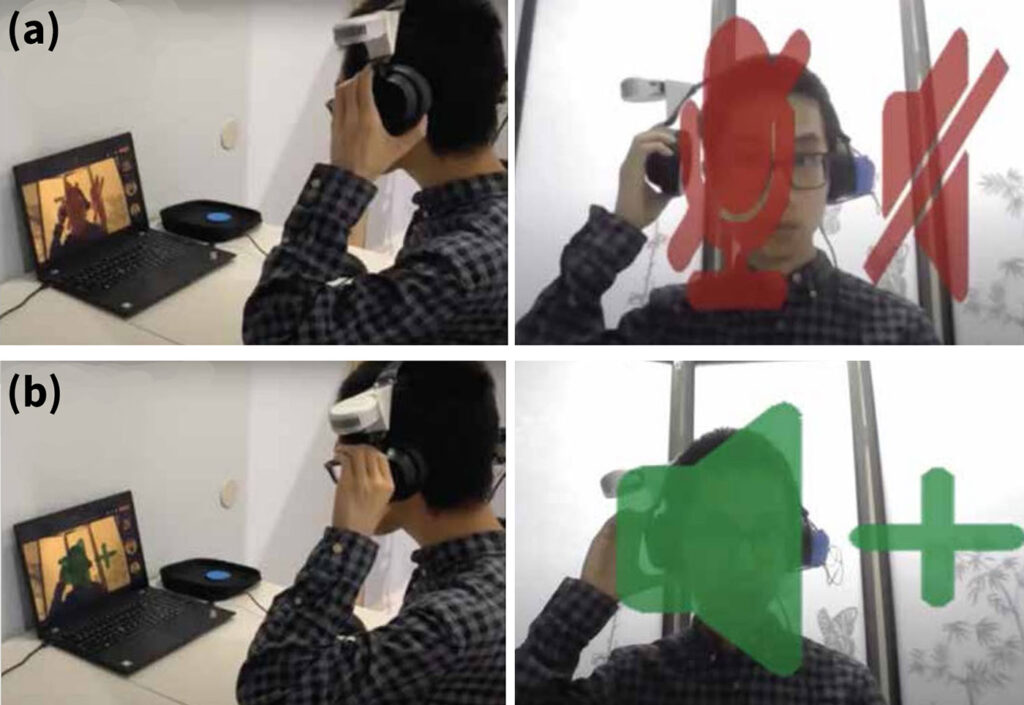This research was accepted by and received a Best Paper Award during ACM Designing Interactive Systems (DIS) 2023, which is dedicated to advancing the field of user-centered system design.
Headphones are traditionally used to provide and manage audio experiences through physical controls and a range of sensors. Nonetheless, these controls and sensors have remained confined to audio input and output functionality, such as adjusting the volume or muting the microphone. Imagine if headphones could transcend their role as mere audio devices.
Because headphones rank among the most popular wearables in the market, we have an exciting opportunity to expand their capabilities through integrating existing sensors with supplementary ones to enable a wide variety of experiences that go beyond traditional audio control. In our paper, “Beyond Audio: Towards a Design Space of Headphones as a Site for Interaction and Sensing,” we share a vision that explores this potential.
By using sensors such as microphones, proximity sensors, motion sensors, inertial measurement units (IMUs), and LiDARs, headphone designers can explore new avenues of input and interaction. The fact that headphones are worn on a person’s head allows for a wide range of applications, such as following head movements, body postures, and hand gestures. Furthermore, as wearable devices, headphones have the potential to provide wearers with context-rich information and enable more intuitive and immersive interactions with their devices and environment beyond traditional button-based controls.
Spotlight: Microsoft Research Podcast
AI Frontiers: The Physics of AI with Sébastien Bubeck
What is intelligence? How does it emerge and how do we measure it? Ashley Llorens and machine learning theorist Sébastian Bubeck discuss accelerating progress in large-scale AI and early experiments with GPT-4.
Potential scenarios for sensor-enhanced headphones
To explore this concept further, we propose augmenting headphones with additional sensors and input widgets. These include:
- IMUs to sense head orientation
- Swappable sets of input controls
- A range-sensing LiDAR that enables the sensing of hand gestures
By incorporating these capabilities, we envision a wide range of applications where headphone input acts as a bridge between the person wearing it and their environment and enable more efficient and context-aware interactions among multiple devices and tasks. For example, a headphone could assist people with applications like video games or help manage interruptions during a video call.
Let’s explore some scenarios to illustrate the potential of our headphone design concept. Consider a person engaged in a video call with teammates when they are suddenly interrupted by a colleague who approaches in person. In this situation, our headphones would be equipped to detect contextual cues, such as when the wearer rotates their head away from a video call, signaling a shift in attention. In response, the headphones could automatically blur the video feed and mute the microphone to protect the wearer’s privacy, as shown in Figure 1. This feature could also communicate to other participants that the wearer is temporarily engaged in another conversation or activity. When the wearer returns their attention to the call, the system removes the blur and reactivates the microphone.

In another privacy-focused scenario, imagine a person simultaneously conversing with multiple teammates in separate video call channels. Our headphone design allows the wearer to control to whom their speech is directed by simply looking at their intended audience, as shown in Figure 2. This directed speech interaction can extend beyond video calls and be applied to other contexts, such as sending targeted voice commands to teammates in a multiplayer video game.

In our paper, we also demonstrate how socially recognizable gestures can introduce new forms of audio-visual control instead of relying solely on on-screen controls. For example, wearers could interact with media through gestural actions, such as cupping their ear towards the audio source to increase the volume while simultaneously reducing ambient noise, as shown in Figure 3. These gestures, ingrained in social and cultural contexts, can serve as both control mechanisms and nonverbal communication signals.

Additionally, we can estimate the wearer’s head gaze through the use of an IMU. When combined with the physical location of computing devices in the wearer’s vicinity, it opens up possibilities for seamless interactions across multiple devices. For instance, during a video call, the wearer can share the screen of the device they are actively focusing on. In this scenario, the wearer shifts their attention from an external monitor to a tablet device. Even though this tablet is not directly connected to the main laptop, our system smoothly transitions the screen sharing for the wearer’s audience in the video call, as shown in Figure 4.

Finally, in our paper we also show the use of embodied interactions, where the wearer’s body movements serve to animate a digital representation of themselves, such as an avatar in a video call, as shown in Figure 5. This feature can also be implemented as a gameplay mechanism. Take a racing game for instance, where the wearer’s body movements could control the vehicle’s steering, shown on the left in Figure 6. To extend this capability, these movements could enable a wearer to peek around obstacles in any first-person game, enhancing the immersion and gameplay experience, shown on the right in Figure 6.


Design space for headphone interactions
We define a design space for interactive headphones through an exploration of two distinct concepts, which we discuss in depth in our paper.
First, we look at the type of input gesture for the interaction, which we further classify into three categories. The gestural input from the wearer might fall under one or more of these categories, which we outline in more detail below and illustrate in Figure 7.
- Touch-based gestures that involve tangible inputs on the headphones, such as buttons or knobs, requiring physical contact by the wearer
- Mid-air gestures, which the wearer makes with their hands in close proximity to the headphones, detected through LiDAR technology
- Head orientation, indicating the direction of the wearer’s attention

The second way that we define the design space is through the context within which the wearer executes the action. Here, design considerations for sensor-enhanced headphones go beyond user intentionality and observed motion. Context-awareness enables these headphones to understand the wearer’s activities, the applications they are engaged with, and the devices in their vicinity, as illustrated in Figure 8. This understanding enables the headphones to provide personalized experiences and seamlessly integrate with the wearer’s environment. The four categories that define this context-awareness are comprised of the following:
- Context-free actions, which produce similar results regardless of the active application, the wearer’s activity, or the social or physical environment.
- Context that is defined by the application with which the wearer is interacting. For example, are they listening to music, on a video call, or watching a movie?
- Context that is defined by the wearer’s body. For example, is the wearer’s gesture close to a body part that has an associated meaning? Eyes might relate to visual functions, ears to audio input, and the mouth to audio output.
- Context that is defined by the wearer’s environment. For example, are there other devices or people around the wearer with whom they might want to interact?

Looking ahead: Expanding the possibilities of HCI with everyday wearables
Sensor-enhanced headphones offer a promising avenue for designers to create immersive and context-aware user experiences. By incorporating sensors, these headphones can capture subtle user behaviors, facilitating seamless interactions and enhancing the wearer’s overall experience.
From safeguarding privacy to providing intuitive control mechanisms, the potential applications for sensor-enhanced headphones are vast and exciting. This exploration with headphones scratches the surface of what context-aware wearable technology can empower its wearers to achieve. Consider the multitude of wearables we use every day that could benefit from integrating similar sensing and interaction capabilities into these devices. For example, imagine a watch that can track your hand movements and detect gestures. By enabling communication between sensor-enhanced wearables, we can establish a cohesive ecosystem for human-computer interaction that spans across applications, devices, and social contexts.
The post Thinking beyond audio: Augmenting headphones for everyday digital interactions appeared first on Microsoft Research.

